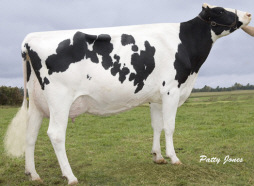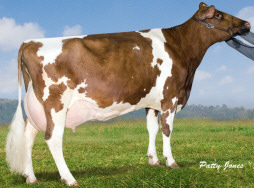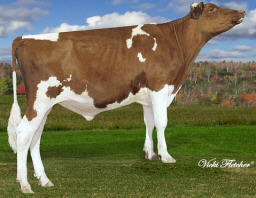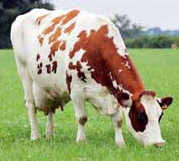



Holstein
History
The Holstein breed originated in Europe. The major historical developement of this breed occured about 2000 years ago in what is now the Netherlands and more specifically in the two northern provices of North Holland and Friesland which lay on either side of the Zuider Zee. The original stock were the black animals and white animals of the Batavians and Friesians, migrant European's who settled in the Rhine Delta region about 2,000 years ago. For many years, Holsteins were bred and strictly culled to obtain animals which would make best use of grass, the area's most abundant resource. The intermingling of these animals evolved into an efficient, high-producing black-and-white dairy cow.Characteristics
 Photo courtesy of West Port Holsteins, www.westportholsteins.ca |
A healthy Holstein calf weighs 90 pounds or more at birth. A mature Holstein cow weighs about 1500 pounds and stand 58 inches tall at the shoulder.
Holstein heifers can be bred at 15 months of age, when they weigh about 800 pounds. It is desirable to have Holstein females calve for the first time between 24 and 27 months of age. Holstein gestation is approximately nine months.
While some cows may live considerably longer, the normal productive life of a Holstein is six years.
Average production for all Holsteins enrolled in official U.S. production-testing programs in 1987 was 17,408 pounds of milk, 632 pounds of butterfat and 550 pounds of protein per year.
There is growing interest in the polled factor in dairy cattle. All breeds have some polled (naturally hornless) cattle. A number of Red & White breeders have shown a special interest in developing polled cattle. A large number of polled young sires, both red and red factor are currently in sampling.
Statistics
Holsteins have the highest milk productions in the world. They have an unequalled genetically anchored achievement ability which has no biological ceiling. Genetic improvements of 1 to 2 percent per year are totally realistic. Photo courtesy of West Port Holsteins, www.westportholsteins.ca |
However, Holsteins, compared to natural breeds, are not as resistant to heat and diseases when in difficult agro-ecological areas. Their reaction to such conditions is a reduced production capacity. Experience has taught that they exhibit divergent adaptation abilities, which should therefore receive attention from a technical point of view when breeding. In the case of cross-breeding with natural breeds the calves show a higher heat tolerance and higher production figures are achieved than in the case of cross-breeding with other cultural breeds.
Holsteins produce vigorous calves distinguished by rapid growth, early maturity and easy care. If they are managed well, they exhibit no fertility problems.
They are good-natured, are easy to handle and can be stabled without any problems. They are also resistant to stress, exhibit a herd mentality and are not solitary animals.
Holsteins are more than just a dairy breed. The animal also contribute to the meat supply worldwide, have a high growth percentage in the fattening sector and produce meat with a fine fibre. In industries aimed exclusively at milk production, they are cross-bred with beef breeds for a better quality veal.
Top producing Holsteins milking twice a day have been known to produce up to 67,914 pounds of milk in 365 days. unexcelled production, greater income over feed costs, unequaled genetic merit, and adaptability to a wide range of environmental conditions Such convincing evidence of genetic superiority has created an active export market for Holstein genetics. Currently, live Holstein females and males and frozen embryos and semen are being exported to more than 50 countries and used extensively to improve foreign food supplies and dairy producer incomes.
Comparative
Genetic Relationships between Lifetime Profit and Type Traits in Spanish Holstein Cows, PDF format Photo courtesy of West Port Holsteins, www.westportholsteins.ca |
Distribution
Holsteins can now be found on every continent and in almost every country.References (the above information was cited from the following sites)
www.ansi.okstate.edu
www.saholstein.co.za
www.westportholsteins.ca


